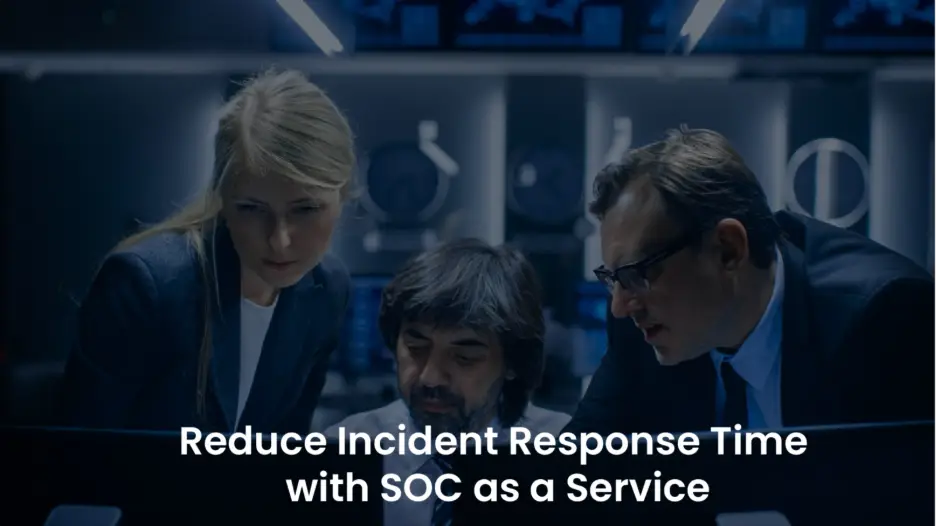
Before delving into the intricacies of SOC as a Service (SOCaaS), it is imperative to grasp the fundamentals of a Security Operations Center (SOC), encompassing its essential functions, capabilities, and the crucial role it undertakes in fortifying an organisation’s digital infrastructure. Understanding this context underscores the importance of SOCaaS.
This article explores how SOC as a Service significantly enhances incident response time by analysing its relevance, best practices, and key performance indicators such as MTTD (Mean Time to Detect) and MTTR (Mean Time to Respond). It discusses the continuous monitoring capabilities of SOCs, the implementation of automated triage processes, and the coordination of responses across various cloud and endpoint environments. Furthermore, it elucidates how integrating SOCaaS with existing security frameworks enhances visibility and bolsters cybersecurity resilience. Readers will gain valuable insights on how a SOC strategy, regular drills, and threat intelligence play a vital role in achieving quicker containment, as well as the benefits of utilising managed SOC services to access expert analysts, advanced tools, and scalable processes without the necessity of developing these capabilities internally.
Effective Strategies for Minimising Incident Response Time with SOC as a Service
To effectively minimise incident response time through SOC as a Service (SOCaaS), organisations must harmonise technology, processes, and expert insights to swiftly identify and contain potential threats before they escalate into serious issues. A dependable managed SOC provider integrates continuous monitoring, cutting-edge automation, and a skilled security team to enhance every aspect of the incident response lifecycle. This collaboration ensures that organisations can respond proactively to threats, thereby significantly reducing the risk of breaches and damage to their digital assets.
A Security Operations Center (SOC) functions as the nerve centre of an organisation’s cybersecurity architecture. When provided as a managed service, SOCaaS integrates critical components such as threat detection, threat intelligence, and incident management into a unified framework, enabling organisations to respond to security incidents in real-time. This capability is crucial for maintaining an effective defensive posture against evolving cyber threats and ensuring that the organisation can effectively manage and mitigate risks associated with data breaches and cyberattacks.
Effective approaches to reducing response time encompass the following:
- Continuous Monitoring and Detection: By employing sophisticated security tools and SIEM (Security Information and Event Management) systems, organisations can meticulously analyse logs and correlate security events across numerous endpoints, networks, and cloud services. This real-time surveillance offers a holistic view of emerging threats, substantially decreasing detection times and aiding in the prevention of potential breaches before they occur.
- Automation and Machine Learning: SOCaaS platforms leverage the capabilities of machine learning to automate routine triage tasks, prioritise critical alerts, and initiate predefined containment protocols. This automation diminishes the duration security analysts spend on manual investigations, resulting in quicker and more effective responses to incidents, thereby enhancing the overall security framework.
- Skilled SOC Team with Clearly Defined Roles: A dedicated response team comprises seasoned SOC analysts, cybersecurity experts, and incident response professionals who operate with clearly delineated roles and responsibilities. This structured approach guarantees that every alert receives immediate and appropriate attention, thus enhancing the overall management of incidents and ensuring that no potential threat goes unnoticed.
- Integrated Threat Intelligence and Proactive Hunting: Proactive threat hunting, supported by comprehensive threat intelligence, facilitates the early detection of suspicious activities, thereby minimising the risk of successful exploitation and significantly strengthening incident response capabilities. This proactive stance enables organisations to stay ahead of potential threats and respond swiftly to emerging risks.
- Unified Security Stack for Enhanced Coordination: SOCaaS consolidates various security operations, threat detection, and information security functions under a single provider. This integration enhances coordination among security operations centres, leading to faster response times and reduced time to resolution for security incidents, ultimately fortifying the organisation’s overall security posture.
Why is SOC as a Service Indispensable for Minimising Incident Response Time?
Here are the compelling reasons why SOCaaS is essential:
- Continuous Visibility Across All Security Domains: SOC as a Service provides real-time visibility across endpoints, networks, and cloud infrastructures, facilitating the early identification of vulnerabilities and unusual behaviours before they escalate into significant security breaches. This continual oversight is vital for maintaining a robust security posture.
- 24/7 Monitoring and Rapid Response Mechanisms: Managed SOC operations function tirelessly around the clock, diligently analysing security alerts and events. This unwavering vigilance guarantees swift incident responses and prompt containment of cyber threats, thereby enhancing the overall security posture of the organisation.
- Access to Expert Security Teams for Timely Intervention: Partnering with a managed service provider offers organisations access to highly trained security professionals and incident response teams. These experts can efficiently assess, prioritise, and respond to incidents promptly, alleviating the financial strain of maintaining an in-house SOC while ensuring quality threat management.
- Automation and Cohesive Security Solutions: SOCaaS integrates advanced security solutions, analytics, and automated response playbooks to streamline incident response strategies, significantly diminishing delays caused by human intervention in threat analysis and remediation. This integration optimises the incident response framework.
- Enhanced Threat Intelligence Capabilities for Proactive Defence: Managed SOC providers employ global threat intelligence to proactively anticipate emerging risks within the evolving threat landscape, effectively bolstering an organisation’s defences against potential cyber threats. This foresight is crucial for staying ahead of adversaries.
- Improved Overall Security Posture Through Integration: By melding automation with expert analysts and adaptable infrastructure, SOCaaS empowers organisations to maintain a resilient security posture, addressing contemporary security demands without overburdening internal resources.
- Strategic Alignment to Focus on Core Objectives: SOC as a Service enables organisations to concentrate on strategic security initiatives, while the third-party provider manages everyday monitoring, detection, and response activities, significantly reducing the mean time to detect and resolve incidents.
- Real-Time Management of Security Incidents for Effective Recovery: Integrated SOC monitoring and analytics provide a comprehensive overview of security events, allowing managed security services to identify, respond to, and recover from potential security incidents with remarkable efficiency and effectiveness.
What Proven Best Practices Can Enhance Incident Response Time with SOCaaS?
Here are the most effective best practices to consider:
- Develop a Comprehensive SOC Strategy: Clearly outline structured processes for detection, escalation, and remediation. A well-defined SOC strategy ensures that each phase of the incident response process is executed effectively across various teams, thereby enhancing overall operational efficiency and effectiveness.
- Implement Continuous Security Monitoring Across All Environments: Ensure round-the-clock security monitoring across all networks, endpoints, and cloud environments. This proactive methodology facilitates early identification of anomalies, significantly decreasing the time required to detect and contain potential threats before they escalate into critical incidents.
- Automate Incident Response Workflows for Enhanced Efficiency: Integrate automation within SOC solutions to expedite triage, analysis, and remediation processes. Automation minimises the necessity for manual intervention while improving the quality of response operations, thus ensuring a swift and effective approach to incident management.
- Leverage Managed Cybersecurity Services for Seamless Scalability: Partnering with specialised cybersecurity service providers allows organisations to effortlessly scale their services while ensuring expert-led threat detection and mitigation without the operational complications associated with maintaining an in-house SOC.
- Conduct Regular Threat Simulations to Enhance Preparedness: Execute simulated attacks, such as DDoS (Distributed Denial of Service) drills, to assess an organisation’s security readiness. These simulations help pinpoint operational deficiencies and refine the incident response process, ultimately strengthening overall resilience.
- Enhance Data Security and Visibility Across All Systems: SOCaaS platforms unify telemetry from various systems, providing comprehensive visibility into network, application, and data security layers. This holistic perspective significantly shortens the interval between detection and containment of threats, thereby fortifying the organisation’s security measures.
- Integrate SOC with Existing Security Tools for Cohesion: Align current security tools and platforms within the managed SOC ecosystem to dismantle silos and enhance overall security outcomes, fostering a collaborative security environment that maximises efficiency.
- Adopt Solutions Compliant with Industry Standards for Improved Effectiveness: Collaborate with reputable vendors, such as Palo Alto Networks, to incorporate standardized security solutions and frameworks that enhance interoperability while minimising the occurrence of false positives, thus ensuring a reliable security posture.
- Continuously Measure and Optimise Incident Response Performance: Regularly track key metrics, including mean time to detect (MTTD) and mean time to respond (MTTR), to uncover opportunities for reducing delays in response cycles and enhancing the maturity of SOC operations.
The Article Reduce Incident Response Time with SOC as a Service Was Found On https://limitsofstrategy.com

